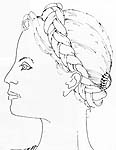 |
|||||||||||||||||||||||
|
Lesson #5: Page 12
These ponytails or a small bun may have been held in place with a string of beads in some cases, as shown by finds of beads at the back of the head from time to time. Click on image for larger version in new window
One of the few figural representations of an Anglo-Saxon woman that we have is a small clay figure from a pot lid from Spong Hill. She wears her hair tied up in a neat bun. Click on image for larger version in new window
There is some suggestion that young, unmarried women wore their hair loose, but once they were married it was bound. Whether this binding took the form of a headband (perhaps of braid) or a knotted style (as shown on some of the gold foils) is uncertain. Men's Hairstyles
'Here in Bordeaux we see the blue-eyed Saxon afraid of the land, accustomed as he is to the sea; along the extreme edges of his pate the razor, refusing to restrain its bite, pushes back the frontier of his hair and, with the growth thus clipped to the skin, his head is reduced and his face enlarged.' Sidonius also describes Frankish warriors: '... on the crown of whose red pates lies the hair that has been drawn towards the front, whilst the neck, exposed by the loss of its covering, shows bright. Their eyes are faint and pale, with a glimmer of greyish blue. Their faces are shaven all round, and instead of beards they have thin moustaches which they run through with a comb. Close fitting garments confine the tall limbs of the men, they are drawn up high so as to expose the knees, and a broad belt supports their narrow middle.' Sidonius also writes of Frankish servants with 'oily top knots', perhaps similar to the Swabian knot. Evidence of early Anglo-Saxon hairstyles being extremely rare, Sidonius' and Tacitus' observations are interesting. Also of interest is the similarity of Sidonius' description of the Frankish warrior's hairstyle with the 'Norman' styles shown on the Bayeux Tapestry some six centuries later! The many combs found in Anglo-Saxon contexts (mainly from cremations and settlements, not burials) suggest that care of the hair was important, and the many tweezers (if used for plucking hair), shears, etc. found in burials show that personal grooming was valued. A large number of razors are also known, although these seem to occur, like combs, mainly in cremation burials. Since most of the settlers were intending to devote themselves to agriculture and colonisation, it is probable that the more extravagant hairstyles of their kinsmen were left behind, except, perhaps, by some of the warriors. The uncropped wildness of the Chatti and the knots of the Swabians were after all, as Tacitus tells us, largely designed to frighten the enemy. Probably the Anglo-Saxons cut their hair fairly short, as the Franks did; by the sixth century long hair seems to have been a style confined to the Merovingian kings in Frankia and Scandinavian warriors. Our only direct evidence for the early Anglo-Saxons comes from highly stylised faces and figures on jewellery. Luxuriant moustaches are suggested on some faces, occasionally with a beard, but most are clean shaven. Hair is occasionally shoulder length, but is usually collar length or shorter (hardly the hairy barbarians many Victorian scholars would have us believe!) The sceptre/whetstone from Sutton Hoo is carved with eight fairly naturalistic representations of men's faces. These show well groomed hairstyles of varying length, some with neat beards, others clean shaven. Click on image for larger version in new window
|
|||||||||||||||||||||||
| Costume
Classroom is a division of The
Costume Gallery, copyright 1997-2001.
Having problems with this webpage contact: questions@costumeclassroom.com |
|||||||||||||||||||||||













